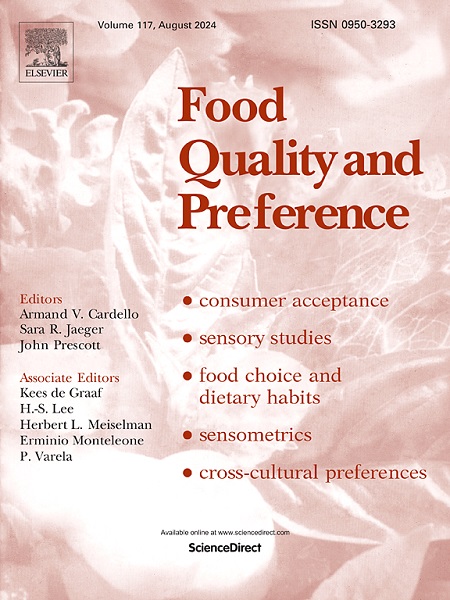Exploration of the relationship between olfaction, food Neophobia and fruit and vegetable acceptance in school-aged children
IF 4.9
1区 农林科学
Q1 FOOD SCIENCE & TECHNOLOGY
引用次数: 0
Abstract
Rejection of food, including fruits and vegetables, is prevalent among children. In adolescents and adults, a link has been observed between food neophobia (the rejection of unfamiliar foods) and olfaction, which plays a key role in food acceptance. However, research on olfaction's role in food acceptance and rejection among children is limited. Utilizing the U-sniff test and the Italian Child Neophobia Scale, this study investigated associations between odor awareness, odor identification, food neophobia, and the acceptance of fruits and vegetables in Swedish children aged 9–12 years (n = 126). A Swedish version of the ChiPSO questionnaire on odor awareness (including subscales for food, social and environmental odors) was developed, and initial validation conducted through back translation, cognitive interviews, and exploratory factor analysis. Fruit and vegetable acceptance was assessed through a questionnaire and a tasting session. Findings indicated that food neophobia was associated with lower fruit and vegetable acceptance (questionnaire ρ = −0.296, p = 0.002; tasting session ρ = −0.273, p = 0.004) but no significant associations observed with odor awareness (ρ = 0.159, p = 0.094) or odor identification performance (ρ = −0.141, p = 0.176). However, odor awareness was negatively associated with vegetable acceptance (ρ = −0.200, p = 0.034), while odor identification performance showed no significant associations (questionnaire ρ = −0.049, p = 0.638; tasting session ρ = −0.101, p = 0.316). A negative association was found between odor identification performance and environmental odor awareness (ρ = −0.269, p = 0.010). This suggests that some children may struggle to identify odors due to emotional reactions and avoidant behaviors, reducing engagement and hindering identification. Further exploration of the relationship between olfaction and children's food acceptance or rejection is encouraged.
求助全文
约1分钟内获得全文
求助全文
来源期刊

Food Quality and Preference
工程技术-食品科技
CiteScore
10.40
自引率
15.10%
发文量
263
审稿时长
38 days
期刊介绍:
Food Quality and Preference is a journal devoted to sensory, consumer and behavioural research in food and non-food products. It publishes original research, critical reviews, and short communications in sensory and consumer science, and sensometrics. In addition, the journal publishes special invited issues on important timely topics and from relevant conferences. These are aimed at bridging the gap between research and application, bringing together authors and readers in consumer and market research, sensory science, sensometrics and sensory evaluation, nutrition and food choice, as well as food research, product development and sensory quality assurance. Submissions to Food Quality and Preference are limited to papers that include some form of human measurement; papers that are limited to physical/chemical measures or the routine application of sensory, consumer or econometric analysis will not be considered unless they specifically make a novel scientific contribution in line with the journal''s coverage as outlined below.
 求助内容:
求助内容: 应助结果提醒方式:
应助结果提醒方式:


